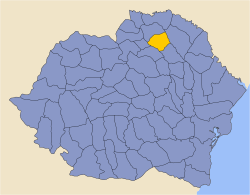Botoșani County
County of Romania From Wikipedia, the free encyclopedia
County of Romania From Wikipedia, the free encyclopedia
Botoșani County (Romanian pronunciation: [botoˈʃanʲ] ) is a county (județ) of Romania, in Western Moldavia (encompassing a few villages in neighbouring Suceava County from Bukovina to the west as well), with the county seat at Botoșani.
Botoșani County
Județul Botoșani | |
|---|---|
County | |
 Former Botoșani County Prefecture | |
 Location of Botoșani County in Romania | |
| Coordinates: 47.84°N 26.82°E | |
| Country | |
| Development region1 | Nord-Est |
| Historic region | Moldavia |
| Capital city (Reședință de județ) | Botoșani |
| Government | |
| • Type | County Council |
| • President of the County Council | Doina Elena Federovici (PSD) |
| • Prefect2 | Sorin Cornilă |
| Area | |
| • Total | 4,986 km2 (1,925 sq mi) |
| • Rank | 29th in Romania |
| Population (2021-12-01)[1] | |
| • Total | 392,821 |
| • Rank | 22nd in Romania |
| • Density | 79/km2 (200/sq mi) |
| Time zone | UTC+2 (EET) |
| • Summer (DST) | UTC+3 (EEST) |
| Postal Code | 71wxyz3 |
| Area code | +40 x314 |
| Car Plates | BT5 |
| GDP | US$1.726 billion (2015) |
| GDP per capita | US$4,18 (2015) |
| Website | County Council County Prefecture |
| 1 as of 2007, the Prefect is not a politician, but a public functionary. He (or she) is not allowed to be a member of a political party, and is banned to have any political activity in the first six months after the resignation (or exclusion) from the public functionary corps 2w, x, y, and z are digits that indicate the city, the street, part of the street, or even the building of the address 3x is a digit indicating the operator: 2 for the former national operator, Romtelecom, and 3 for the other ground telephone networks 4used on both the plates of the vehicles that operate only in the county limits (like utility vehicles, ATVs, etc.), and the ones used outside the county | |
As of 31 October 2011, it had a population of 412,626 and the population density was 83/km2.[2]

This is a predominantly agricultural county; the main industries are the textile industry, the food industry, the electrical components industry, and the glass and porcelain industry.
The Stânca–Costești Hydroelectric Power Station is one of the largest hydroelectric power plants in Romania. Work on it started in 1973, and it was completed in 1978, at the same time as the Stânca-Costești Dam. They are both situated on the Prut River, between Stânca in Botoșani County and Costești, Rîșcani.
The Botoșani County Council, renewed at the 2020 local elections, consists of 32 counsellors, with the following party composition:[5]
| Party | Seats | Current County Council | |||||||||||||||
|---|---|---|---|---|---|---|---|---|---|---|---|---|---|---|---|---|---|
| National Liberal Party (PNL) | 15 | ||||||||||||||||
| Social Democratic Party (PSD) | 15 | ||||||||||||||||
| PRO Romania (PRO) | 2 | ||||||||||||||||


Botoșani County has 2 municipalities, 5 towns and 71 communes:
Județul Botoșani | |
|---|---|
County (Județ) | |
 The Botoșani County Prefecture building from the interwar period, currently the county museum. | |
 | |
| Country | |
| Historic region | Moldavia |
| Capital city (Reședință de județ) | Botoșani |
| Area | |
| • Total | 3,077 km2 (1,188 sq mi) |
| Population (1930) | |
| • Total | 218,258 |
| • Density | 71/km2 (180/sq mi) |
| Time zone | UTC+2 (EET) |
| • Summer (DST) | UTC+3 (EEST) |
During the years between the world wars, the county extended over different territory than currently. It was located in the northeastern part of Romania, in the northeast of the region or Moldavia. The county included the southern part of the present county and the northern part of the current Iași County. It was bordered to the west by the counties of Suceava and Baia, to the north by Dorohoi, to the east by Bălți, and to the south with Iași.

In 1930, the county was divided into three districts (plăși):[6]
Administration was re-organized in 1938, comprising 4 districts:
According to the 1930 census data, the county population was 218,258 inhabitants, ethnically, 88.8% were Romanians, 9.0% were Jews, as well as other minorities. From the religious point of view, 89.4% were Eastern Orthodox, 9.2% Jewish, 0.7% Roman Catholic, as well as other minorities.
In 1930, the county's urban population was 50,320 inhabitants, comprising ethnically 64.9% Romanians, 31.3% Jews, 0.9% Germans, as well as other minorities. From the religious point of view, the urban population was composed of Eastern Orthodox (64.5%), Jewish (32.3%), Roman Catholic (2.1%), as well as other minorities.
Natives of the county include:
Seamless Wikipedia browsing. On steroids.
Every time you click a link to Wikipedia, Wiktionary or Wikiquote in your browser's search results, it will show the modern Wikiwand interface.
Wikiwand extension is a five stars, simple, with minimum permission required to keep your browsing private, safe and transparent.